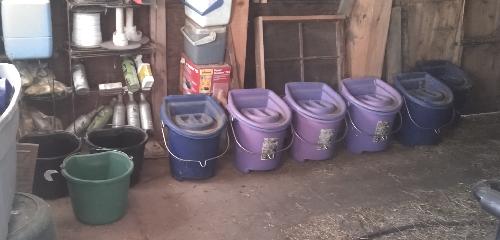
Keeping Liquid Gold Flowing When the World Freezes
There’s a certain magic to life on the land in winter – the frosty sparkle on bare branches, and the soft creaks of a barn under snowy drifts. Whether your barn has running water or you’re just starting out with a temporary shelter, one of the biggest winter challenges you’ll face is keeping water from freezing.
If your barn or coop isn’t heated, or you’re starting out on newly purchased land with only a temporary shelter without water, keeping water liquid can be tricky. Most barns, like ours, have electricity for lighting and water heaters, but many don’t have running water. Heating barns is like trying to warm the great outdoors, it’ll spin the electric meter fast. Plus, unheated water pipes risk freezing and bursting, which wastes time and money and causes so much damage.
We actually cheat a bit as our barn is a side-hill barn, partially built into a hill. Where we store water is somewhat underground. Between that and being right next to the stable, we get a little ambient heat from the ground and body heat from those two 1000#+ horses living on the other side of the door. Still, we can only hold liquid water to about 20ºF, but it helps!
That means winter chores include hauling and storing water. Here are some tips to make the job a little easier.
A Thrifty Sip: Water-Saving Tips for Winter
Just like buttoning up the barn against winter winds, conserving water simplifies chores and makes supplies last:
- Skip rinsing and scrubbing when you can. Keep a spare clean set of buckets or dishes handy for swapping out the especially grimy ones.
- Top off waterers and troughs instead of emptying and refilling. Use a colander or strainer to sift out hay, leaves, and debris before they spoil the water.
- If you’re camping out on vacant land:
- Use paper plates or compostable bowls on extra-cold days to save water.
- Choose hearty meals that require little or no water for preparation. Every drop saved is one less to haul!
- Carry store-bought drinks instead of powders that need mixing.
- Keep a stash of strong-seal bags for laundry, trash, or messy jobs to keep things tidy.
Remember: less water in means less wastewater to wrangle or freeze.
The Best (But Most Expensive) Solution
If you’re lucky enough to have a well, it sits below the frost line, keeping water liquid all winter. For shallow wells (up to about 25 feet), old-fashioned hand pumps work well, although you’ll need to pour a bit of water in to prime them. Frost-free yard hydrants are magic: installed below the frost line, they deliver water without priming.
Cool as a Cellar
Got a spot shielded from wind and freezing? A dug-out cellar, root house, foundation, or a nook under the barn can work wonders. Place heavy water containers down beneath the frost’s reach, insulate with hay or straw, and keep the access hatch snug. It’s an old-timer’s trick that really works.
The Right Containers Matter
Don’t trust old milk jugs, a freeze will split them wide open. Use sturdy, food-grade plastic or rubber containers. Round shapes lose heat slower than square ones. Always leave space at the top because water expands as it freezes. A burst jug isn’t fun in January.
Bundle Up (That Means Your Water Too)
Thick insulation keeps your water from freezing just like a flannel shirt keeps you warm. Nest containers inside bigger barrels padded with hay, straw, foam, or old blankets. Dry insulation is essential, so shield it from water and snow. Wet insulation freezes and loses its insulating power.
Let the Sun Have a Go At It
A dark jug sitting in full winter sun can stay thawed longer on sunny days. Nature’s heater gives you a few extra liquid hours when you need them most.
Garden Hoses
If you’re like us and rely on garden hoses to bring water from the house to your barn and coops most of the year, drain them each night to get a little more thawed time on days above freezing. Be aware hoses can get stiff or crack if temperatures dip below 25ºF, even when drained. Storing them in the house will extend their usefulness.
Water Carts and Ice Fishing Sleds
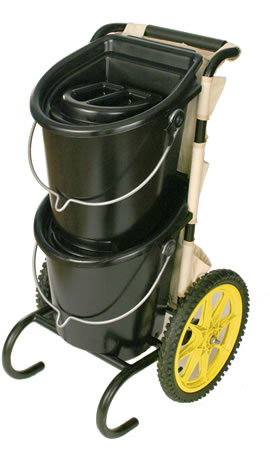
If water isn’t accessible in the barn or coop, water carts make life easier. Fill containers at the house and wheel them down rather than hauling buckets one at a time.
Unfortunately, the above water cart system is no longer made, but you can build something similar with a hand truck and a little ingenuity.

When wheels won’t work, an ice fishing sled glides easily over snow and ice and can hold a lot of weight.
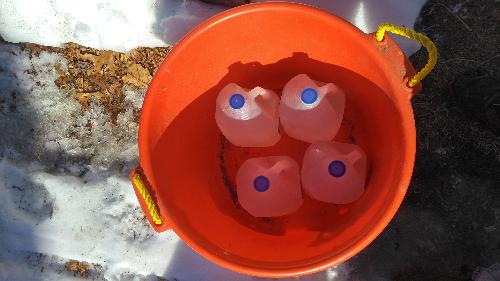
No sled? A muck bucket works just as well.
Amazon has a great deal on a sled and muck bucket.
Big Tanks Freeze Slower
Keep water tanks and barrels topped up—leaving enough room for expansion. More water means slower freezing and more flexibility for you.
As a Last Resort, A Little Heat
A safe, vented propane or kerosene heater in a shed can thaw frozen barrels. Always prioritize safety and never use fuel heaters in tight, unventilated spaces. Never leave heaters unattended.
More Farm-Friendly Water Tricks
- Melt snow if you must, but always filter and boil it before drinking or giving it to animals.
- Store rainwater in insulated barrels as a backup during mild winters.
- If you’re lucky enough to have a spring or running creek, purify that water for safe use.
- Keep a big insulated jug or thermos by the fire. It’s a blessing for early mornings and late-night checks.
Safety, Quality, and a Little TLC
Use clean, food-safe containers and inspect regularly for cracks or leaks. Nothing ruins a chore day like a puddle of frozen water. Protect your stash from critters, bugs, and barn odors by sealing lids tightly. Check water daily; it’s easier to melt a little ice than chip apart a frozen block.
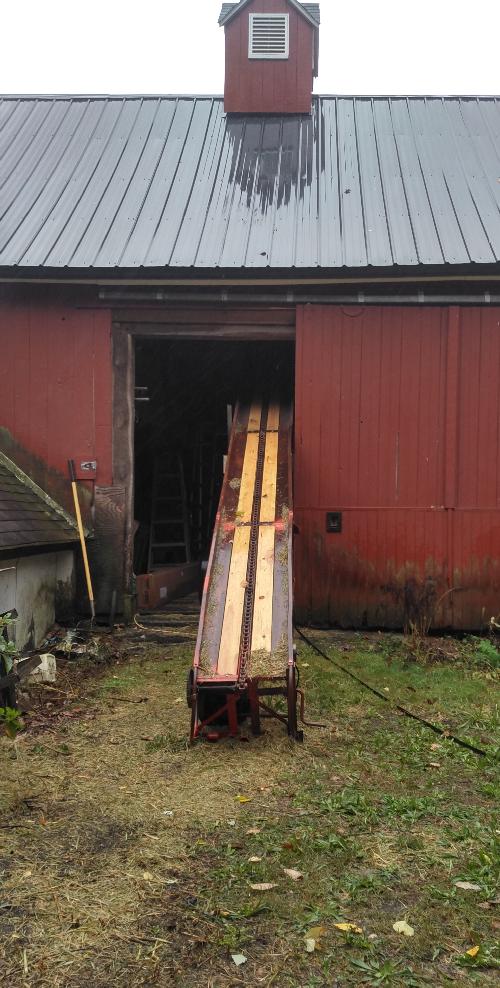
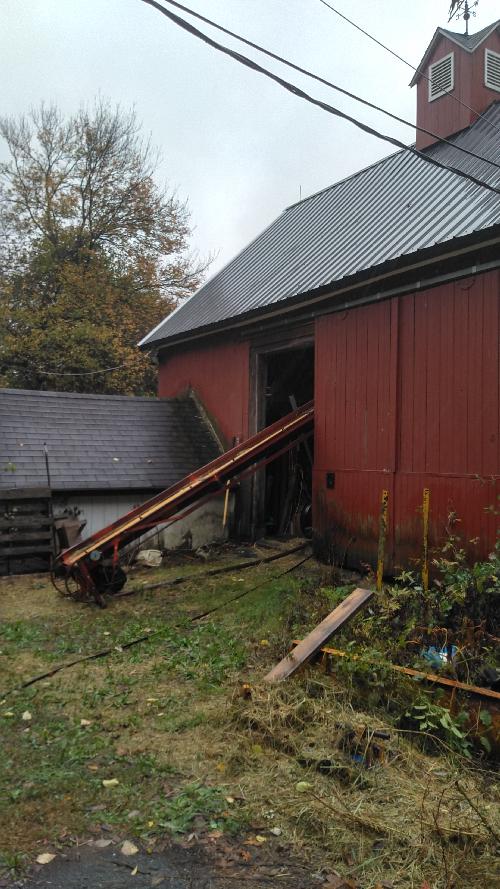
Elevate Your Hay Game!
Last weekend we loaded 330 bales of hay into the lofts in our barn. That’s enough, combined with last year’s leftovers, to keep our two horses and two goats well-fed until Thanksgiving 2026.
There’s nothing quite like the peace of mind that comes from knowing the herd’s winter meals are secured well before snow, sleet, or ice arrive. For our animals, hay is their main food. They depend on it all year long, and for goats especially, there’s simply no substitute if we run out.
That’s why our hay elevator earns its keep every year. I still remember our first winter, dragging bales up to the loft by hand with a block and tackle. A traditional system, but definitely unforgiving on the back and shoulders, and it took forever!
That all changed when our hay supplier unearthed an old elevator from his lot, tuned it up, and sold it to us for a bargain. Since then, moving hay has become one of the simpler chores on the farm.
It’s still labor intensive since the elevator doesn’t do the actual stacking of the bales. Ideally it takes 4-6 people a half day, but having it done that fast is fantastic.
The history of hay handling shows just how much simple machines like hay elevators have improved life for livestock keepers. Before baling became widespread in the late nineteenth century, farmers stored loose hay, both in inside lofts and outside stacks, and used pitchforks to move it.
By the 1860s, mechanical hay forks made loading easier, but it was the invention and adoption of baled hay that truly changed things.
Early balers made it possible to compress and tie hay in manageable packages, cutting down on spoilage and allowing more feed to fit in less space. These processes were powered manually at first.
But by the 1930s, mechanized balers took over, allowing farmers to process hay more quickly and efficiently. And hay elevators evolved from hay forks to move these packages up into lofts.
Today, hay elevators come in different lengths and configurations, sized for everything from small barns to big operations. The key is to customize storage space to the elevator and vice versa. Once the system is set, putting up a season’s worth of hay will keep the animals’ dinner plates full all winter.
So, if your farm has hay-hungry mouths and a loft for storage, treat your future self (and your back) to a hay elevator. You’ll never regret making winter prep just a little bit easier.
.
Play & Stay Essentials for Your Pet
Whether it’s time to play or time to rest, Petmate has you covered.
Explore our must-have Chuckit! toys for high-energy fun and trusted Petmate kennels designed for safe, comfortable downtime—because your pet deserves the best of both worlds.
Shop Petmate Here – 15% Off Through Oct 31st – Use Code FALL15
Click to Read Previous Issues of This Newsletter
.
Click to Subscribe to This NewsletterYou can also subscribe by clicking on the “Subscribe” button on the top left of previous newsletters.
Interested in other newsletters?
Love what you read or want to help keep the lights on?
Click to Make a Voluntary DonationThis post contains affiliate links, which means I may earn a commission
if you click through and make a purchase through these links.
This post is intended for informational purposes only. All information provided does not constitute veterinary medical advice and should not be used as a replacement for professional veterinary consultation. I am not a veterinarian or any other medical professional. Please consult your veterinarian regarding any change in treatment or supplementation for your companion animal.
.
